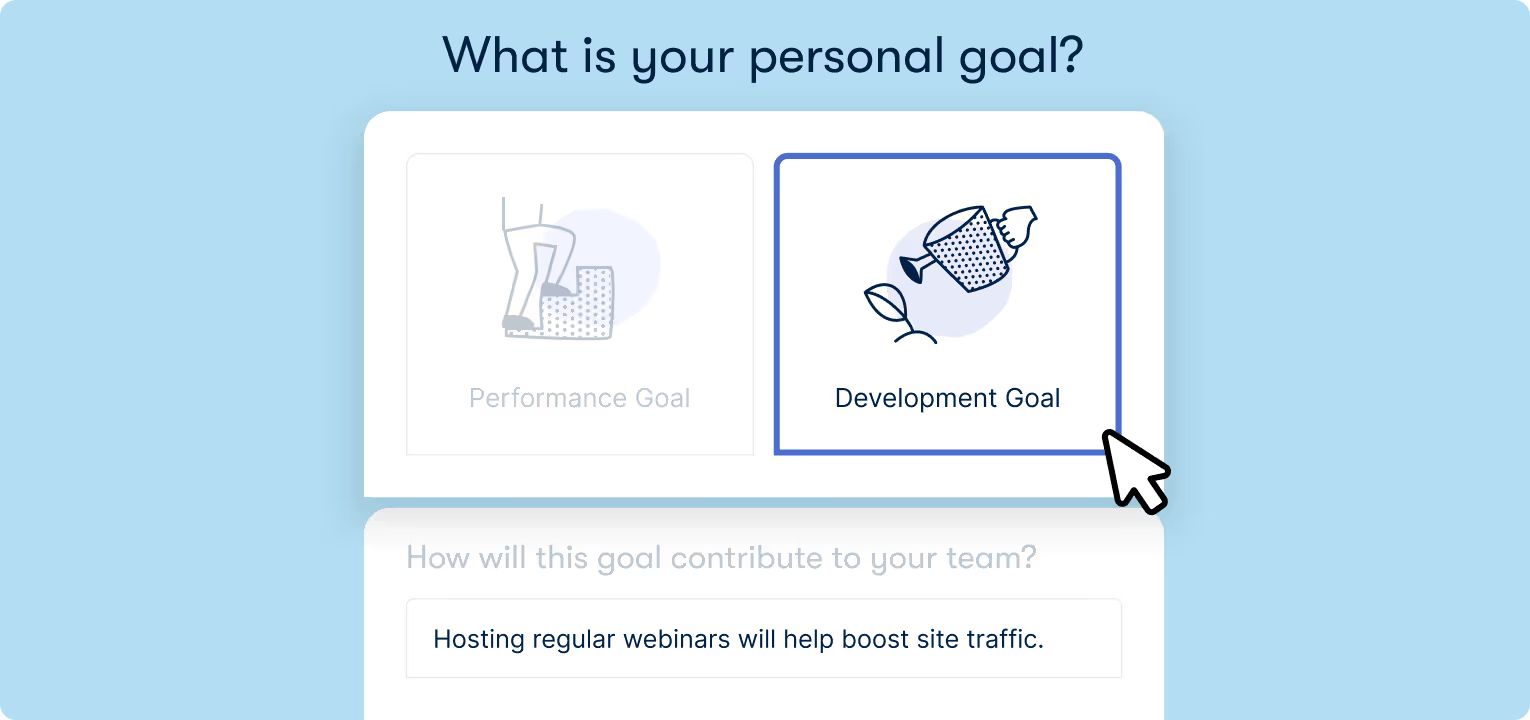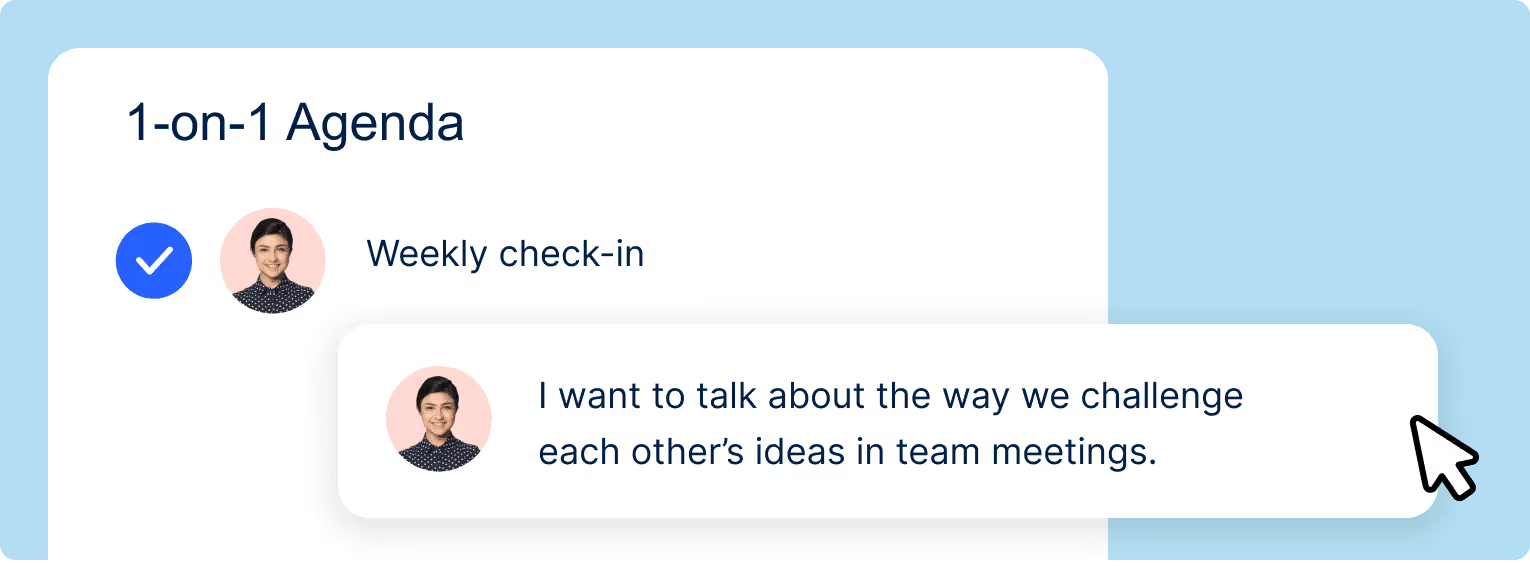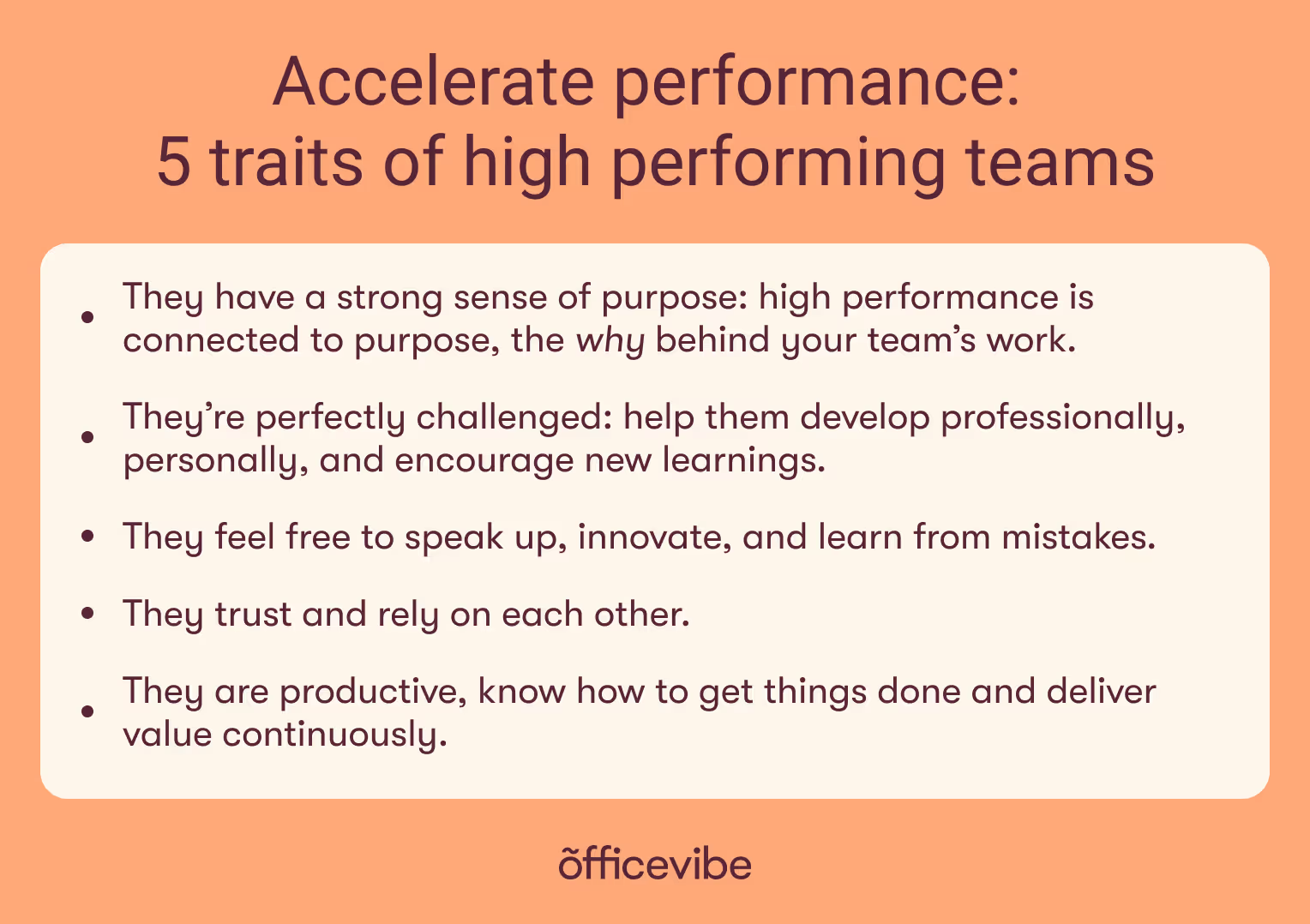What makes a high-performing team? 5 key traits and lessons for managers

Discover Workleap Officevibe's benchmark report on 12 key employee engagement metrics

What makes up a high performing team? According to experts, what do they have in common and how can managers be conductors of performance?
For most of us, the morning ride to the office is now more of a stumble than a commute. Your team was physically fractured and now operates as a virtual team. And yet, the work and corporate objectives remain the same.
So, as a team leader, you might struggle to boost your team’s performance and team effectiveness. We understand and we’re here to help.
While the word team can be used in many different contexts, at its core:
A team is a collective of individuals that strive to achieve a common goal.
On the field, the goal is to win a championship. In the workplace, it may be to develop an effective marketing strategy for a new product. But ultimately, success is achieved through a process of combined efforts we call teamwork.
We’re going to explore 5 characteristics of high performing teams and then share 4 essential tips for team leaders to fuel productivity and performance. These teamwork lessons will help you to lead your team to new heights!
5 traits of the highest performing teams
You’re about to uncover the key characteristics of high performing teams and what contributes to high levels of team performance.
As a team leader, if you're able to integrate these elements into your team culture, you'll also boost teamwork.
See this is as your guide to managing an effective team that will take your team leadership to the next level.
They have a strong sense of purpose
Why? This is the question that has endured since our earliest words. There’s something that drives us that comes from within; an intrinsic motivator that is connected to purpose.
When we do something we care about, we do it better. High performing teams are able to draw a direct line from the work they do in their day-to-day, to the tangible impact it has made on the company, and even the world.
Purpose comes from your team's ability to personally connect with their work.
Knowing the why behind the what will provide motivation to the how.
Your team should be acutely aware of the purpose of their work and how it serves the bigger picture.
How does this look in action in your leadership role?
Talk to each team member and link their work with:
1- The real impact their personal job has
2- How the team's purpose aligns with the organizational goals and values.
By helping them to connect the dots, you create something that isn’t just a job, but something that is vibrant and purposeful.
They’re perfectly challenged
Bored at work? Good luck being productive.
Once you’ve connected your work to purpose, it's key to make sure that your team's mandate encourages them to grow professionally and learn continuously.
If work is too easy, mundane, or too routinary, your team may find themselves uninspired and spiralling into a state of disinterest. On the flip side, if the work is too tough, your team may feel helpless, anxious and stressed.
So to find that happy place where the challenge sparks motivation, encourage your team to step outside their comfort zone.
Here are some examples of challenges that you, as a manager, can incorporate into the team dynamics:
- Include a goal (personal or team-wide) that includes learning a new skill.
- Ask them to come up with an innovative idea per quarter.
- Encourage systematic experimentation of new approaches.
- Give individual team members responsibilities that impact the team (like team building, establishing team goals, communicate updates/wins with the organization).
High performing teams are motivated by a challenge that they believe is feasible, with a solid understanding of what they need to do to achieve this goal. A proper challenge will encourage collaboration, feedback, and reinforce the purpose of the work.
James Clear, the author of the New York Times bestseller, Atomic Habits, refers to this as The Goldilocks Rule, which states that,
Goals are golden. Set them, achieve them, and surpass them. That’s the objective, isn’t it?
Use Officevibe's one on one meeting tool to keep track of your team goals. Keep your team challenged and celebrate when new milestones are reached.!
Sign up for free.

They have psychological safety at the core
Let's take some time to reflect:
- Is your team culture collaborative and open?
- Do you and your colleagues feel comfortable sharing constructive feedback with one another?
- Is your team willing to take risks without the fear of failure?
High performing teams have all this, and it’s called psychological safety.
Psychologically safe teams demonstrate high performance, because they don’t shame mistakes, but rather use them as building blocks.
Teamwork is about trust, creativity, and an openness to working fearlessly in pursuit of the best possible outcomes. But as we all know, the best outcomes are rarely achieved without a few bumps, turns, and hiccups along the way.
Those are the learning moments where being agile, collaborative, and open will lead to growth.
When teams have this sense of safety, not only do they perform, they innovate.
Create an environment where everyone has the confidence to create with the unfiltered support of their peers and an open mind. Start thinking “we’re in this together,” so how can we help each other?
They can trust and depend on each other
In order for psychological safety to be effective, your team needs to trust and depend on one another.
In the new landscape virtual teams, we find ourselves physically distanced from our peers and perhaps interacting with teammates we’ve never met. How can we develop mutual trust to work better?
Don’t worry, we aren’t suggesting a blindfolded team-building exercise. What we are suggesting is that as a manager, you lead by example.
Intentionally prioritize building authentic team connections as much as you prioritize hitting those targets.
We like to think of dependability as “keeping it real.”
If you say something, you mean it. If you promise to deliver, you deliver. If you give feedback, it’s your honest contribution to the group goals. In essence, trust builds a bond of security and dependability.
Being able to rely on your teammates catapults teamwork and results.
They are collectively productive
And now, the final question: Is your team productive?
One of the most telling signs of a high performing team is that they produce work, deliver value, and get things done.
This productivity is a result of everything mentioned above. Trust and dependability in one another, the safety to fail together and learn as a team, and a common sense of purpose that drives you toward the finish line.
Productivity is the ultimate goal and the gold standard of high performing teams.
It’s important to continuously review if your team is efficient, effective, and producing results.
What does that look like? Your team is at the pinnacle of high performance, focused, goal-oriented, and delivering value to your clients.
What do experts on productivity have to say?
We reached out to our friends at Toggl Track for advice. They are thought leaders on productivity, and leading experts on working smarter and better.
So, productivity means you have momentum and your team has found their rhythm, but beware, that can be short-lived if unchecked and an aura of complacency takes over.
Strive to continuously evolve, by asking your team how we can do things better.
Ask your team to reflect on the following at the end of the week:
Team productivity reflection checklist:
❏ Did you give and receive honest feedback?
❏ Did you collaborate or see collaboration amongst your colleagues?
❏ Did you sense boredom or complacency?
❏ Did you feel energized and motivated?
❏ Did you accomplish a high priority task?
❏ Did you deliver value to your client?
❏ Do you know the direction your team is going?
4 solid tips for team leaders to drive high performing teams
Now that you’ve identified the characteristics of high performing teams, let’s transfer that knowledge into action. Here are some tips, lessons and tools to help you lead your team of high performers.
Be clear about roles and responsibilities
A coach won’t just send their players into battle. There is careful preparation, direction, and clarity given on how everyone contributes throughout the process. Employees need this same sense of clarity before jumping into projects.
If you want your team to work collaboratively and win together, everyone needs to know their part. Most importantly, shine a light on how every role assists in the win.
Teams win championships.
Own your mistakes
The second teamwork lesson is to lead by example by admitting to your mistakes as a leader, and encouraging teams to surface theirs instead of sweeping them under the rug.
Create a culture where mistakes are perceived as learnings, not failures.
To do this, start team meetings by identifying your own mistakes, what you’ve learned, and how you’ll perform better next time.
Set goals collaboratively
Give people a stake in their development by not telling them what to do, but asking them how they want to contribute as experts.
When you include your team in the goal-setting process they develop shared accountability and have a sense of ownership, both key for high performance.
Basically, give your team the crystal clear objectives they need, and then let them decide how they are going to achieve them.
Before setting goals together, ask your team to reflect on the following:
- Where are we going?
- Why do we want to go there?
- How are we going to get there?
Create a safe space for feedback and difficult discussions
Teamwork is about honesty. Lead “honesty sessions” where your team has the opportunity to ask questions, give feedback, and have those tough talks.
Organize these safe spaces and give your team that platform to grow. Collaborate, learn, share and discuss your journey to high performance.
Pro tip: Use tools like Officevibe to easily plan your meetings ahead of time and develop collaborative agendas. Give your team the ability to think ahead and add points they want to discuss, and automatically make your team part of the conversation.
Sign up for free!

Your team is starting to vibe as you embody the characteristics and employ the tools above.
As a team leader you have the opportunity to pioneer change and watch as your teammates see more personal fulfillment parallel to high performance becoming the workplace standard.
You aren’t alone in this. Remember you are surrounded by teammates that are there to provide you with feedback and support, just as you are to them.
Build a culture where employees feel safe to share, create, and question. Where goals are set to challenge, not deter. Where you connect the dots by giving purpose to the job. Where your team is productive because you have mastered all of the above.
Too busy? We got you.
You can save the image below (drag to your desktop or right-click and save) with the main and most actionable lessons from this article, and/or send them to your email.

High-performing teams FAQ
What make a high performing team?
A high-performing team is a group of individuals who collaborate effectively, communicate openly, and consistently achieve exceptional results in their shared goals.
What are the key characteristics of a high-performing team?
High-performing teams are characterized by clear goals, effective communication, trust and collaboration among members, shared accountability, and a commitment to continuous learning and improvement.
How can leadership contribute to building a high-performing team?
Strong leadership plays a crucial role in building high-performing teams. Leaders should set a compelling vision, empower team members, provide guidance and support, recognize achievements, and facilitate conflict resolution and problem-solving.
What strategies can be used to build and sustain high-performing teams?
Strategies include establishing a strong team culture, hiring the right people, building effective communication channels, encouraging trust and collaboration, and fostering continuous learning and development.
How can team performance be measured and evaluated?
Team performance can be measured and evaluated by defining metrics and key performance indicators (KPIs), conducting regular performance assessments and feedback sessions, and adjusting strategies based on performance data.
Give HR and managers the clarity, confidence, and connection to lead better every day.


%20(1).avif)


.avif)
.avif)








